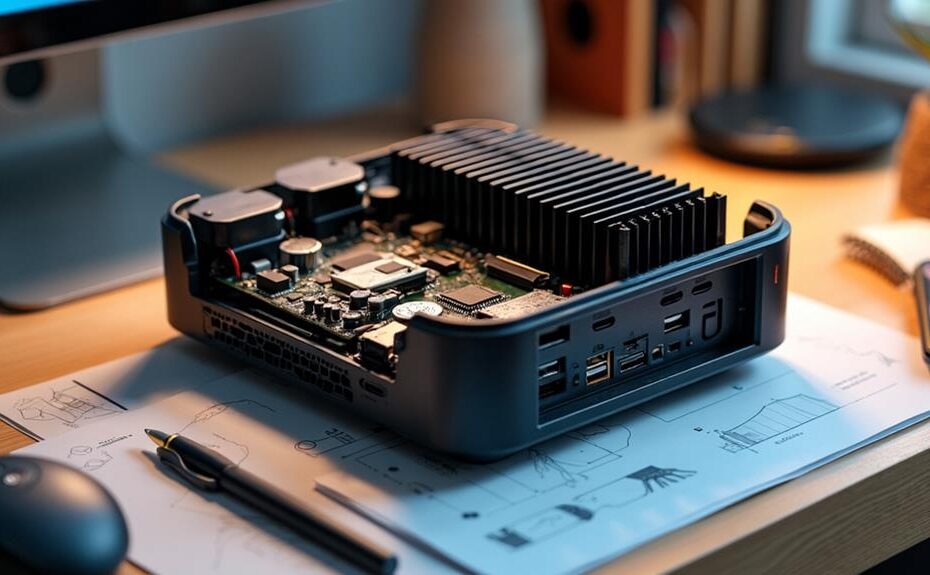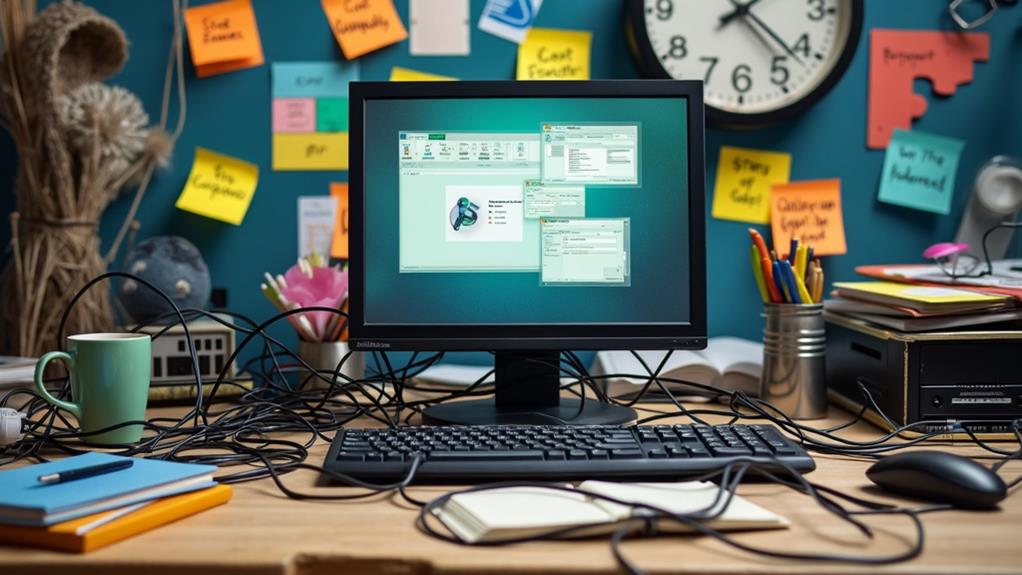



Modern mini PCs adhere to several essential hardware design principles that emphasize compactness, energy efficiency, and modularity. You'll notice the focus on SWaP-C—size, weight, power, and cost—guaranteeing peak performance in limited space. Low-power processors minimize heat generation, often enabling fanless designs. The integration of modular components, like expandable DDR4 RAM and high-speed M.2 SSDs, allows for customization and upgrades. Extensive connectivity options enhance adaptability with various peripherals. Additionally, advanced thermal management guarantees stable operation. Understanding these principles lays the groundwork for appreciating the ongoing evolution in mini PC technology, offering insights into future developments.
Key Takeaways
- SWaP-C optimization emphasizes compactness, lightweight construction, energy efficiency, and cost-effectiveness in miniature designs.
- Low-power processors, like Intel Atom and Celeron, reduce thermal output, enabling fanless designs.
- Modular components allow for easy upgrades of RAM and storage, enhancing customization and longevity.
- Extensive connectivity options, including multiple USB ports and built-in wireless, support diverse peripheral integration.
- Compliance with environmental resilience standards ensures durability against shocks, temperature variations, and dust exposure.
Overview of Mini PCs
Mini PCs are revolutionizing the way we perceive computing power in compact forms. These small form factor computers outperform traditional desktop towers and laptops, making them versatile for various applications like business, education, and industrial use. Utilizing low-power Intel processors, such as the Core series, they deliver a balance of performance and energy efficiency, often featuring TDP ratings considerably lower than their larger counterparts. Remarkably, models like the Dell OptiPlex 7070 Micro and the Lenovo ThinkCentre M720q exemplify how modern mini PCs can provide powerful performance in a compact design, catering to office needs.
Modern mini PCs typically support expandable DDR4 SO-DIMM RAM, enabling configurations up to 64GB, which is essential for demanding tasks. They rely on high-speed SSD storage, with M.2 SSDs providing not only exceptional performance but also ample capacity for data-intensive applications. Connectivity is a critical feature, as you'll find multiple ports, including USB, HDMI, and LAN, allowing for seamless integration with various peripherals and networks.
Mini PCs come in two primary forms: barebones kits, which require additional components for setup, and pre-configured systems that include RAM, storage, and operating systems, ready for immediate use. This flexibility makes mini PCs an attractive option for users seeking powerful computing solutions in a compact design.
Design Principles of Mini PCs
Designing mini PCs hinges on the principles of SWaP-C optimization, which emphasizes creating devices that are compact, lightweight, energy-efficient, and cost-effective while maximizing compute density and portability. The use of low-power processors, such as Intel Atom or Celeron, considerably reduces thermal output, facilitating fanless designs that enhance reliability and minimize noise. This approach not only supports a compact size but also guarantees energy-efficient operation. Additionally, performance metrics and benchmarks are essential in guiding the design of mini PCs to confirm they can handle resource-intensive tasks effectively.
Moreover, mini PCs often feature modular designs, allowing for easy upgrades and seamless integration with legacy systems. This adaptability accommodates various applications and user requirements, making these devices versatile. Extensive connectivity is another critical design principle; many models incorporate multiple I/O ports, including USB, HDMI, and audio jacks, which offer thorough peripheral support while maintaining a streamlined form factor.
To further enhance performance, the adoption of advanced storage solutions like M.2 SSDs is prevalent in modern mini PCs. These storage options enable faster data transfer rates, catering to users' demands for speed and reliability in compact systems. Collectively, these principles create a robust framework for mini PCs, guaranteeing they meet the diverse needs of users in an increasingly mobile and connected world.
Performance Optimization Techniques
Enhancing performance in mini PCs involves a combination of hardware choices and system configurations tailored to meet specific user demands. Utilizing low-power processors like Intel Atom or Celeron enables efficient power consumption while delivering sufficient performance for everyday tasks. These processors typically have a thermal design power (TDP) ranging from 10 to 17 watts, allowing for energy efficiency without sacrificing capability. For instance, models like the KAMRUI AK1PLUS Mini PC utilize the 12th Gen Intel Alder Lake N95 Quad-Core processor, offering a powerful performance boost for multitasking and casual gaming, making it an excellent choice for both home and business use 16GB DDR4 RAM.
Integrating M.2 SSDs greatly enhances performance due to their superior read and write speeds compared to traditional 2.5-inch drives, resulting in quicker boot times and application loading. Coupled with DDR4 SO-DIMM RAM, which can be expanded up to 64GB, you can effectively support multitasking and demanding applications.
The compact form factors of mini PCs facilitate advanced thermal management systems, ensuring peak performance during heavy workloads without the bulk of traditional cooling solutions. Additionally, the inclusion of PCIe slots in select models allows for the addition of dedicated graphics cards, enhancing graphics performance—crucial for gaming and CAD applications. By focusing on these performance enhancement techniques, you can maximize the utility and efficiency of your mini PC while keeping energy costs low.
Thermal Management Strategies
While effective thermal management is crucial for maintaining performance, it's important to implement strategies that suit the compact nature of mini PCs. These devices typically utilize low-power processors with a Thermal Design Power (TDP) ranging from 10 to 17 watts, markedly reducing heat generation compared to traditional desktops. To manage this heat, many mini PCs adopt passive cooling methods, favoring fanless designs that minimize noise and enhance reliability.
In addition to passive cooling, employing thermal conductive materials is necessary for dissipating heat efficiently across components. This prevents overheating and guarantees peak performance during extended use. Airflow optimization plays a critical role, with strategically positioned vents and heatsinks promoting natural convection and maintaining lower internal temperatures.
For higher-end mini PCs, advanced thermal management solutions like liquid cooling may be implemented, especially when dedicated graphics cards are utilized for demanding applications. These strategies collectively enhance cooling efficiency, ensuring that the system remains stable under load. By focusing on these thermal management techniques, you can maximize the performance and longevity of your mini PC in various environments.
Component Integration Approaches
How do modern mini PCs achieve a balance between compactness and performance? The answer lies in their component integration approaches. By utilizing low-power processors like Intel Atom or Celeron chips, these systems deliver adequate performance while keeping energy consumption low. This efficiency is essential, as it allows mini PCs to operate effectively without the thermal issues typical of traditional desktops.
The modular design of modern mini PCs is another critical aspect. It enables you to easily upgrade or replace components, such as SO-DIMM RAM and M.2 SSDs, to enhance storage capacity and memory without the need to replace the entire unit. SO-DIMM RAM supports configurations ranging from 4GB to 64GB, catering to diverse user needs for multitasking.
Furthermore, M.2 SSDs are increasingly favored for their faster data transfer rates and compact size compared to traditional drives. Enhanced connectivity options, including multiple USB ports, HDMI, and built-in Wi-Fi and Bluetooth, facilitate seamless integration with various peripherals. Together, these elements represent the cutting edge of computing technology, ensuring that modern mini PCs meet both performance and compactness requirements efficiently.
Connectivity and Expansion Options
Mini PCs excel not only in component integration but also in their connectivity and expansion options, which greatly improve user experience. You'll find a variety of connectivity options available, including multiple USB ports, HDMI, and DisplayPort, allowing you to connect various peripherals effortlessly. Built-in wireless connectivity, such as Wi-Fi and Bluetooth, is standard, eliminating the need for additional hardware and promoting mobility.
Many Mini PCs come equipped with replaceable lids or back panel expansion bays, enabling you to upgrade or add connectivity options as your needs evolve. If you're into gaming or graphic-intensive tasks, certain high-performance models provide PCIe slots for installing dedicated graphics cards, considerably boosting their capabilities.
Additionally, Mini PCs support multiple operating systems, including Android, Windows, and Linux, giving you the flexibility to customize your computing environment. This adaptability guarantees that your Mini PC can grow with your requirements, making it a versatile choice for various applications. Overall, the combination of extensive connectivity options and expansion capabilities makes Mini PCs a compelling solution for both casual users and power users alike.
Energy Efficiency Considerations
In today's technology landscape, energy efficiency plays an essential role in the design and operation of Mini PCs. These devices typically utilize low-power processors with a thermal design power (TDP) of 10 to 17 watts, a stark contrast to traditional desktops that consume between 100 and 150 watts. This significant reduction in power consumption translates into substantial cost savings; for instance, operating 60 traditional desktops can cost around $3,085 annually, while the same number of Mini PCs costs about $308.
Moreover, many Mini PCs incorporate solid-state drives (SSDs), which not only enhance data access speeds but also lower power consumption compared to traditional hard disk drives (HDDs). The compact size and lightweight design of Mini PCs facilitate more efficient cooling, reducing reliance on active cooling solutions that can further increase energy use.
Ultimately, energy-efficient designs in Mini PCs align with environmental sustainability goals, making them particularly well-suited for energy-conscious environments such as schools and offices. By prioritizing energy efficiency, you not only improve operational performance but also contribute to a more sustainable future, reflecting an increasingly important consideration in modern hardware design.
Modularity and Customization Features
As you explore the capabilities of modern Mini PCs, you'll find that their modularity and customization features are essential to meeting diverse user needs. These systems are designed for easy upgrades, allowing you to replace or enhance components like RAM, storage, and graphics cards. With accessible RAM slots and M.2 interfaces for storage types, you can effortlessly boost performance to match your requirements.
Customization options are plentiful; you can select specific processors and memory capacities tailored to your workflow. Many Mini PCs come with replaceable lids or back panels, facilitating additional port expansions. This design enhances connectivity, eliminating the need for cumbersome external adapters.
The use of standardized form factors, such as SODIMM for memory, simplifies the upgrade process across different models, ensuring compatibility. Additionally, some Mini PCs support a modular open systems approach, which allows for seamless integration with both legacy and modern systems. This flexibility is vital for diverse applications, whether you're gaming, designing, or conducting business tasks. Ultimately, the modularity and customization features of modern Mini PCs empower you to create a personalized computing experience that evolves with your needs.
Environmental Resilience Standards
Often overlooked in the design of compact computing systems, environmental resilience standards play an indispensable role in ensuring that Mini PCs function effectively in demanding conditions. These standards often include compliance with MIL-STD-810G, which guarantees shock resistance, vibration tolerance, and robustness against extreme temperatures. Many Mini PCs also meet IP67 standards, providing essential protection against dust and temporary water immersion, enhancing reliability in harsh environments.
The integration of low-power components is fundamental for achieving environmental resilience. These components generate less heat, decreasing the risk of overheating, especially in challenging operational settings. Additionally, the modular design of Mini PCs allows for straightforward upgrades and repairs, ensuring system longevity without compromising structural integrity.
Thermal management is another key factor. Many modern Mini PCs utilize fanless designs to maintain silent operation while effectively dissipating heat. This approach not only contributes to the durability of the system but also aligns with the requirements of various industrial applications. By adhering to these environmental resilience standards, Mini PCs are well-equipped to thrive in diverse and demanding environments, proving their versatility and reliability in various use cases.
Future Trends in Mini PC Design
Mini PC design is evolving rapidly, driven by technological advancements and changing user demands. You're likely to see a significant shift towards energy-efficient components, particularly ARM-based processors. These processors deliver lower power consumption while still providing the performance you need for everyday tasks. As gaming and professional applications increasingly necessitate high-performance graphics, expect more Mini PCs to include dedicated GPU slots. This innovation will allow you to upgrade graphics capabilities without replacing the entire system.
With DDR5 RAM gaining mainstream traction in 2023, Mini PCs will experience faster speeds and increased memory bandwidth, enhancing your multitasking capabilities. Advanced thermal management solutions, such as vapor chamber cooling and heat pipes, will become standard to effectively dissipate heat from these higher-performance components while maintaining compact designs.
Furthermore, the trend toward modular designs will enable you to customize and upgrade specific components like storage and memory easily. This aligns with the growing emphasis on sustainability and longevity in technology, ensuring your Mini PC remains relevant and functional for years to come. As these trends unfold, Mini PCs will offer enhanced performance, adaptability, and efficiency tailored to your evolving needs.
Disclosure: As an Amazon Associate, I earn from qualifying purchases.





